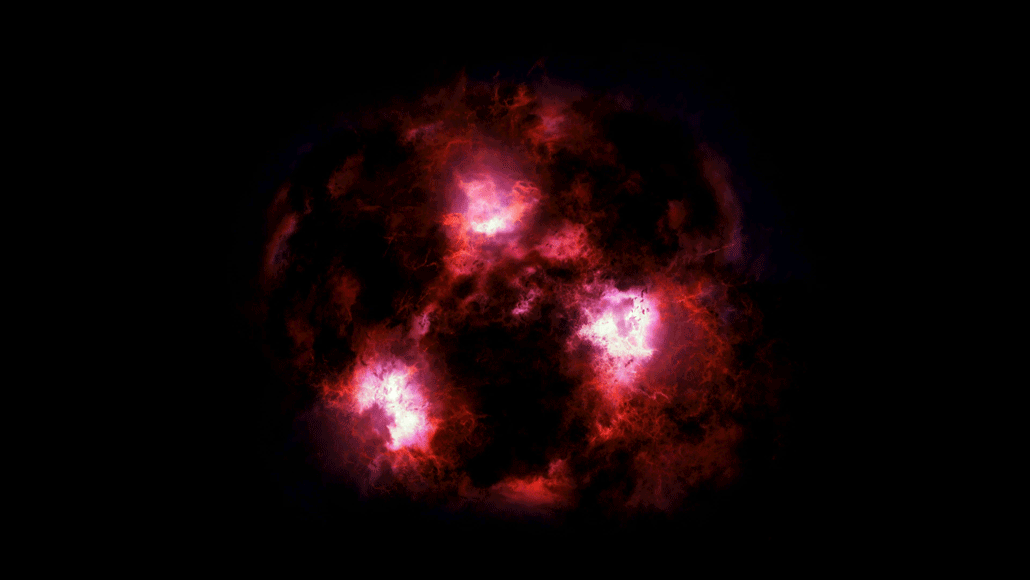Dust-shrouded monster is a snapshot from the early universe
These observations could help explain how galaxies in the early universe grew their stars

Scientists have spotted a monster galaxy from the early universe that may have looked something like this illustration. Back then, galaxies were making more stars and were more blobby looking. This latest galactic glimpse suggests there may be more massive, early galaxies waiting to be found.
James Josephides/Swinburne Astronomy Productions, Christina Williams/University of Arizona, Ivo Labbe/Swinburne
Scientists have stumbled upon a rare beast of a galaxy that had been hiding in dust. The faint signal from this far-off monster was lurking in the background as scientists were focusing on closer galaxies.
With roughly the same number of stars as our galaxy — the Milky Way — this newly discovered one was big for its time. It also was churning out some 100 times more stars than the Milky Way is now, says Christina Williams. An astronomer at the University of Arizona in Tuscon, Williams was part of the team that first spotted the ancient galaxy.
Scientists had observed such old, massive galaxies before. But few had been spotted while still forming stars. “This is a much more dramatic galaxy than the Milky Way,” notes Williams.
Her team described the newfound star system October 22 in the Astrophysical Journal.
Light from this galaxy came from 12.5 billion light years away, Williams and her team estimate. Because the light took so long to reach Earth, it had to have come from the distant past — within a couple of billion years of the Big Bang.
The finding also suggests that similar galaxies await discovery.
Seeing through the dust
Scientists found the galaxy with a group of radio telescopes in Chile. They are known as ALMA (for the Atacama Large Millimeter/submillimeter Array). Although super-sensitive, ALMA can image only a small part of the sky at one time. “That’s why it’s so remarkable that this system was even detected,” says Alexandra Pope. She’s an astronomer at the University of Massachusetts in Amherst. She was not part of the new study.
Based on the analysis by Williams’ team, there could be many similar galaxies out there. And they may have contributed a lot of stars. Between one-fifth to one-quarter of the mass of stars in galaxies at that time could have come from systems like this one, Pope says.
“Stars are the building blocks of galaxies,” she notes. They make the carbon, hydrogen and other elements that are building blocks of people, too. “Understanding when and where the stars are built up in the universe,” Pope says, “helps us understand our place in the universe.”
Our understanding of how galaxies grow stars comes mostly from observing visible light, she notes. But telescopes that pick up visible light, such as the Hubble Space Telescope, can miss a lot, she adds. They can’t see galaxies shrouded in gas and dust, like this one is.
“Stars tend to form in dense clouds of gas and dust. You can think of it like smoke,” says Peter Capak. He works at the California Institute of Technology in Pasadena. Star birth gives off characteristic blue and ultraviolet light. But because of the size of the dust particles, they absorb those types of light. That hides the galaxy, explains this astronomer, who was not involved with the work.
Radio telescopes such as ALMA look at longer wavelengths — around 1 to 3 millimeters (0.04 to 0.12 inch). These are wavelengths of nonvisible radiation. This radiation is similar to that used by cell phones or generated in microwave ovens. These wavelengths pass through dust. That lets researchers see what was behind the clouds. “What you’re actually seeing is heat from the stars,” Capak notes. “It’s sort of like an indirect picture.”
Appreciating rare glimpses
Because it’s been so hard to find these galaxies, every observation counts, Capak says. Researchers were clever in scouring the background of other objects to find this new galaxy, he says. But new instruments coming online soon should be able to spot many more early galaxies. Among them is the James Webb space telescope, due to launch in 2021.
“That observatory is going to revolutionize our view of the early universe,” says Williams. It will be able to reveal older stars and galaxies, and with better resolution.
And that’s exciting, she points out, because that early period was a much more happening time in the universe. Back then, galaxies were more extreme, she says. They were forming stars at a much faster rate. “Right now, the universe around us is a calm and chill place,” Williams says. “There’s not a lot of activity.”
With more glimpses of early galaxies, scientists hope to figure out how galaxies evolve. For instance: Do they grow from within, or do they spread from their outer edges?
These data may point to where the shapes of galaxies come from. Galaxies back then looked a lot different from grand spirals, such as the Milky Way. “They look like these blobs that are still developing,” Williams says. She says that even this massive galaxy likely looked a bit blobby.







